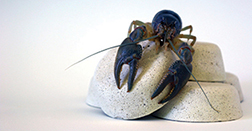Forty billion pounds of wild fish are used as crustacean fishing bait every year, consuming approximately one-third of the global catch of such forage fish. This $20-billion bait market plays a critical role in the vibrancy of commercial fisheries worldwide. Forage fish represent a primary food source for most marine mammals, seabirds, and larger fish; they also are a key nutritional component for humans throughout the world, especially in developing countries.
Competing demands for these valuable species have mounted in recent decades, diverting large volumes from coastal fishing communities to more lucrative uses, such as aquaculture and agriculture feed, domestic pet food, dietary supplements, and cosmetics. New fishing limits have also been implemented to protect specific ecosystems. For example, in 2014, 200 million pounds of herring — a fish popularly used as lobster bait — were captured on the East Coast of the U.S. The catch quota imposed this year will limit the total haul to less than one-fifth of the 2014 harvest. In combination, these factors spell disaster for the fishing fleets that rely on forage fish for their livelihoods.

▲ OrganoBait is a synthetic alternative to using wild bait-fish for capturing crustaceans. It is poised to reduce over-fishing of forage fish and enhance sustainability in the $20-billion global bait market.
Supported by the National Science Foundation (NSF), Kepley BioSystems has developed OrganoBait, a synthetic fish bait. OrganoBait is the ultimate “bait and switch” — a calcium-based tablet calibrated to mimic the odor of decaying fish that can serve as a sustainable replacement for traditional bait.
The OrganoBait tablet is the culmination of Kepley BioSystems’ advances in matrix science and manufacturing. The tablet’s tunable matrix is composed of hygroscopic complements, binders, and solvents; each element plays a role in the dissolution and emission of chemosensory molecules that attract fish and crustaceans. The researchers at Kepley BioSystems defined and optimized matrices through the addition of dispersion inhibitors and accelerants to meet dissolution requirements for various applications and geographic regions. They tested the matrices through laboratory simulation and regional field trials to validate performance in temperatures ranging from 4°C to 27°C and soak durations of 1–12 days.
The researchers also analyzed decaying fish to identify the chemosensory molecules that their tablet would need to emit to best attract fish and crustaceans. Spectral analysis revealed that the most potent attractants, biogenic amines, were formed by decarboxylation of amino acids in decaying flesh. Then they used these findings to formulate synthetic bait tablets capable of immediate emission of chemotactic molecules (traditional bait requires a day to produce trace amounts of biological decomposition molecules). Tablets were also fortified with sustainable, plant-based proteins to provide nourishment to captured crustaceans awaiting trap retrieval. Each synthetic bait tablet is formulated to replicate forage fish tissue as characterized by specific molecules, as well as by concentration, solubility, and rate of release of discrete biochemical components.
Kepley BioSystems will offer tailored OrganoBait formulations to meet the needs of diverse species and conditions (e.g., water temperatures, depth, salinity, tides, and catch duration). The company’s production process has been optimized at ambient temperatures and they plan to pilot a manufacturing module with a capacity of 4,000 baits per hour. By scaling up their manufacturing process to deliver effective synthetic alternatives for bait, the company hopes to conserve billions of forage fish, so those fish can serve as nourishment to other species along the global food chain.
Moving forward, Kepley BioSystems will continue to seek corporate investment partnerships for commercialization and distribution. Significant customer opportunities include the Gulf States’ crayfish sector; the New England lobster industry, which recently added restrictions on herring fishing; and the Mid-Atlantic states’ blue crab fisheries. The Southeastern stone crab market has also continued to grow, with great demand despite high prices driven by declining capture rates. Internationally, demand for Chinese crayfish has burgeoned, as crayfish delicacies have accelerated as the fastest growing food trend in China, approaching a $25-billion industry. Preliminary field trials have also demonstrated OrganoBait can serve as a natural fish attractant and aggregator in addition to crustacean bait — this represents another avenue of potential development.
This technology was funded through the NSF Small Business Innovation Research Program.
This article was prepared by the National Science Foundation in partnership with CEP.

Copyright Permissions
Would you like to reuse content from CEP Magazine? It’s easy to request permission to reuse content. Simply click here to connect instantly to licensing services, where you can choose from a list of options regarding how you would like to reuse the desired content and complete the transaction.
